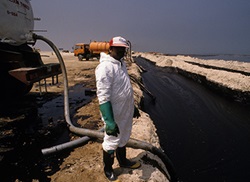Land

Farms and Grasslands
As spilled oil on land prevents water absorption by the soil, spills on agricultural locations or grasslands have the effect of choking off plant life. If a spill occurs in these environments, the highest response priorities are to prevent oil from leaching into groundwater or entering waterways as run-off, and to return the soil to productive use as quickly as possible.
Berms and trenches can be used to contain the spill, as long as their use does not allow the oil to leach into the soil. Where there is no danger to the water table, the contaminated area can be flooded, which “floats” the oil or moves it to the water’s surface, as it is typically lighter than water. This technique allows for recovery via vacuums and skimmers. Other possible techniques include mechanical removal of contaminated soil, in-situ burning, sorbents, and bioremediation.
Cities and Towns
In urban environments, spill response strategies place primary emphasis on protecting human health and restoring usability to the site of the spill as quickly as possible. Since the "urban" banner can encompass everything from paved surfaces to forests and parks, the specific response must be tailored to the affected ecosystem.
In these environments, recovery of spilled oil is a top priority, as it can leach into groundwater or enter rivers and streams as run-off. Because used oil should never be flushed into the sewage system, oil recycling plans are of the utmost importance. Berms and trenches can be used to contain the spill. In some cases, the spilled area can be flooded to "float" the oil, or move it to the water’s surface, as it is typically lighter than water, to allow for recovery. Vacuums, skimmers, shoreline cleaning agents, and sorbents may also be used, along with bioremediation. Earth-moving equipment can recover contaminated soil for disposal.

